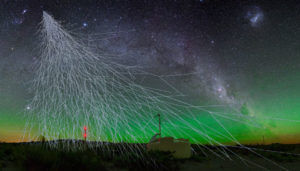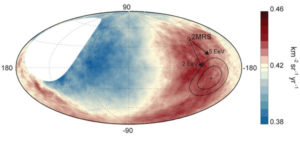Astronomers have detected more extremely energetic cosmic particles coming from one side of the sky than the other.

A. Chantelauze / S. Staffi / L. Bret
Particles traveling at fair fractions of the speed of light hit Earth all the time. These ridiculously energetic entities, called cosmic rays, are protons and larger atomic nuclei from space. Their energies range from about a billion to beyond 10 million trillion electron volts (109 to 1020 eV), or up to 10 million times higher than the energy at which the Large Hadron Collider smashes protons together. (Incidentally, this is why we know the LHC won’t create dangerous microscopic black holes.)
Astronomers think the lower-energy cosmic rays (which are far more common) come from within the Milky Way, particularly from star-forming regions and supernova remnants. The more energetic ones — we’re talking 1,000 trillion eV — are thought to come from outside the galaxy.
The best way to tell is by determining which direction the cosmic rays come from. But that’s not easy. The Milky Way’s magnetic field scrambles these particles’ paths, analogous to how thick fog scatters light, John Gallagher III and Francis Halzen (both University of Wisconsin, Madison) write in a perspective piece in the September 22nd Science. “Just as light seems to come from all directions because it scatters over short distances in fog, cosmic rays scattered by magnetic fields also appear to arrive uniformly across the sky,” they explain.
But the more energetic the particle, the better its chances for evading the magnetic fog. The most energetic ones should be able to travel fairly unimpeded, meaning astronomers have a shot at determining where they come from. Previous work has hinted at the existence of at least one hotspot.

Pierre Auger Collaboration / Science 2017: DOI 10.1126/science.aan4338
Now, the Pierre Auger Collaboration reports that they see more of the speediest cosmic rays coming from one side of the sky than the other.
The Pierre Auger Observatory uses 1,600 tanks, each filled with 12 tons of water, spread across 3,000 square kilometers (1,200 square miles) in Argentina to detect cosmic rays and the showers of particles they create in Earth’s atmosphere. Over 14 years, the collaboration detected 30,000 cosmic rays with energies above 8 million trillion eV. Tracing back each particle to its origin on the sky, the team found a dipole pattern — one side has more than the other.
The effect isn’t much: For the same size patch of sky and per square kilometer of tank-covered ground receiving the particles, there are 0.08 more particles per year detected coming from one side versus the other. (For comparison, on average about one particle hits per square kilometer per year.) But the difference is there.
On the sky, the center of the dipole lies in the vicinity of Canis Major, just below the galactic plane. The team notes in the same issue of Science that more galaxies lie on this side of the sky, too, so perhaps there’s a connection to the cosmic structure surrounding the Milky Way. However, the match-up isn’t exact; it’s still unclear whether there’s any correlation.
Regardless, the distribution is not what’s expected if these cosmic rays come from the Milky Way. The two-tone effect is also 10 times stronger than what would be caused by Earth’s motion with respect to cosmic structures. Therefore, the result strongly favors the long-standing idea that the most energetic cosmic rays come from outside our galaxy.
References:
The Pierre Auger Collaboration. “Observation of a large-scale anisotropy in the arrival directions of cosmic rays about 8 × 1018 eV.” Science. September 22, 2017.
John S. Gallagher III and Francis Halzen. “New angle on cosmic rays.” Science. September 22, 2017.
Get a head start on next year: pick up the latest Sky & Telescope calendars and almanacs.
 2
2









Comments
uwidavid
September 22, 2017 at 8:58 am
They actually detected 30,000 cosmic rays (not 3000). With only 3000 a 0.08 anisotropy would not be statistically significant.
You must be logged in to post a comment.
Camille M. CarlislePost Author
September 22, 2017 at 9:35 am
Whoops! Pesky zero. Thanks for the catch, I've updated the text.
You must be logged in to post a comment.
You must be logged in to post a comment.